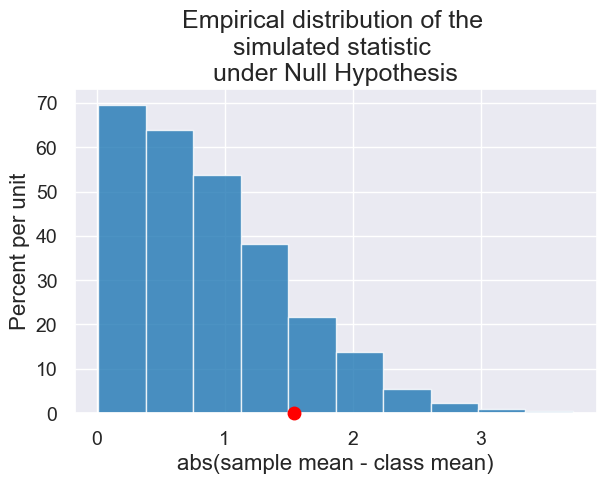Hypothesis Testing
Contents
Hypothesis Testing#
from datascience import *
from cs104 import *
import numpy as np
%matplotlib inline
1. Multiple Categories: Alameda Jury Panels#
# data from ACLU study
jury = Table().with_columns(
'Ethnicity', make_array('Asian/PI', 'Black/AA', 'Caucasian', 'Hispanic', 'Other'),
'Population (Eligible)', make_array(0.15, 0.18, 0.54, 0.12, 0.01),
'Observed (Panels)', make_array(0.26, 0.08, 0.54, 0.08, 0.04)
)
jury
| Ethnicity | Population (Eligible) | Observed (Panels) |
|---|---|---|
| Asian/PI | 0.15 | 0.26 |
| Black/AA | 0.18 | 0.08 |
| Caucasian | 0.54 | 0.54 |
| Hispanic | 0.12 | 0.08 |
| Other | 0.01 | 0.04 |
jury.barh('Ethnicity')
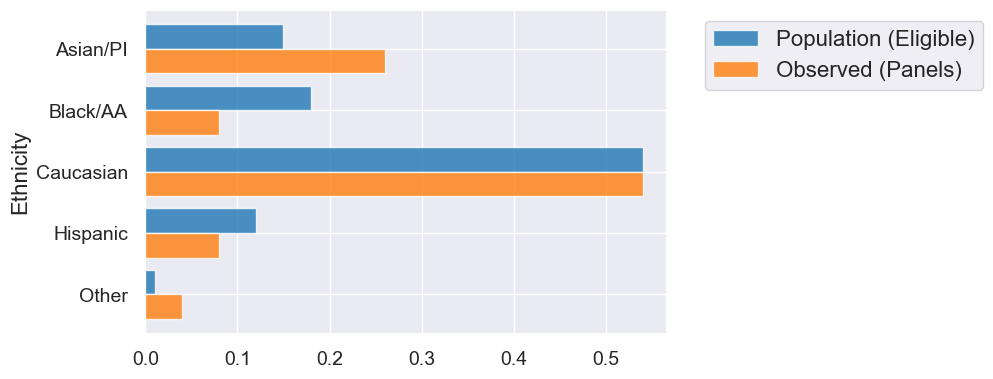
eligible_population = jury.column('Population (Eligible)')
#What we see in the real-world data
observed_sample_size = 1453
#Our simulation will use "sample proportions" function
sample_proportions(observed_sample_size, eligible_population)
array([0.1541638 , 0.18375774, 0.53475568, 0.11975224, 0.00757054])
simulated_sample = sample_proportions(observed_sample_size, eligible_population)
simulated = jury.with_columns('Simulated sample', simulated_sample)
simulated
| Ethnicity | Population (Eligible) | Observed (Panels) | Simulated sample |
|---|---|---|---|
| Asian/PI | 0.15 | 0.26 | 0.153476 |
| Black/AA | 0.18 | 0.08 | 0.178252 |
| Caucasian | 0.54 | 0.54 | 0.538885 |
| Hispanic | 0.12 | 0.08 | 0.117688 |
| Other | 0.01 | 0.04 | 0.0116999 |
simulated.barh('Ethnicity')
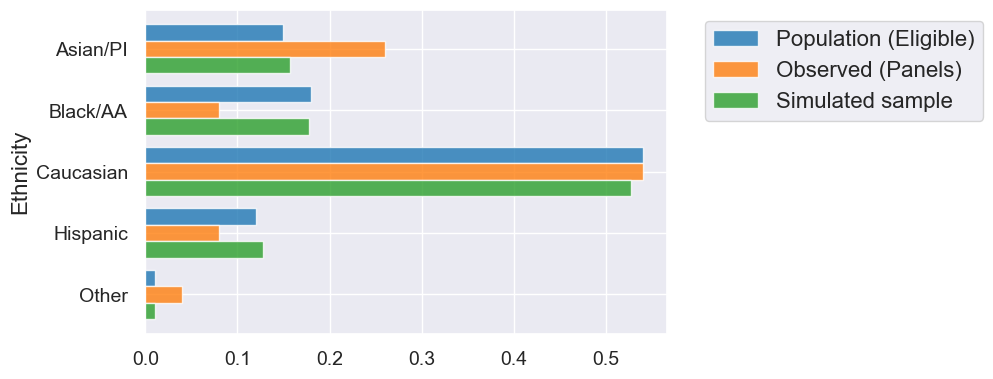
TVD Statistic: Distance Between Two Distributions#
jury.barh('Ethnicity')
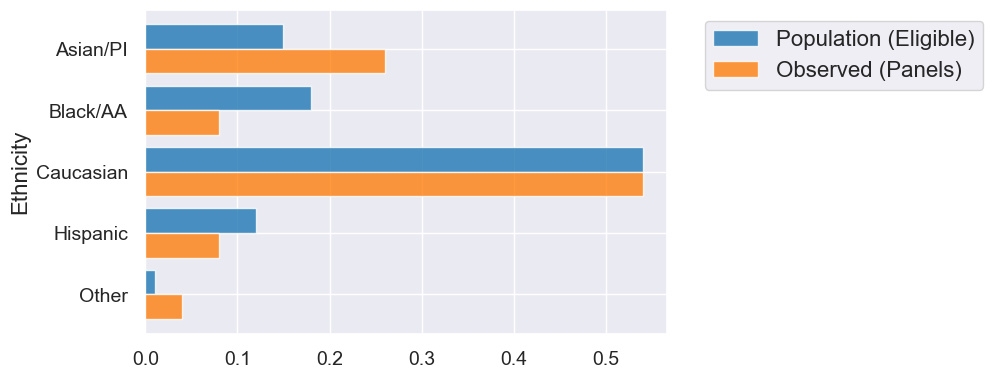
jury_with_diffs = jury.with_columns(
'Difference', jury.column('Observed (Panels)') - jury.column('Population (Eligible)')
)
jury_with_diffs
| Ethnicity | Population (Eligible) | Observed (Panels) | Difference |
|---|---|---|---|
| Asian/PI | 0.15 | 0.26 | 0.11 |
| Black/AA | 0.18 | 0.08 | -0.1 |
| Caucasian | 0.54 | 0.54 | 0 |
| Hispanic | 0.12 | 0.08 | -0.04 |
| Other | 0.01 | 0.04 | 0.03 |
jury_with_diffs = jury_with_diffs.with_columns(
'Absolute Difference', np.abs(jury_with_diffs.column('Difference'))
)
jury_with_diffs
| Ethnicity | Population (Eligible) | Observed (Panels) | Difference | Absolute Difference |
|---|---|---|---|---|
| Asian/PI | 0.15 | 0.26 | 0.11 | 0.11 |
| Black/AA | 0.18 | 0.08 | -0.1 | 0.1 |
| Caucasian | 0.54 | 0.54 | 0 | 0 |
| Hispanic | 0.12 | 0.08 | -0.04 | 0.04 |
| Other | 0.01 | 0.04 | 0.03 | 0.03 |
sum(jury_with_diffs.column('Absolute Difference') / 2)
0.14
def total_variation_distance(distribution1, distribution2):
return sum(np.abs(distribution1 - distribution2)) / 2
observed_panels = jury.column('Observed (Panels)')
total_variation_distance(observed_panels, eligible_population)
0.14
simulated_panel = sample_proportions(observed_sample_size, eligible_population)
total_variation_distance(simulated_panel, eligible_population)
0.023386097728836902
Simulating TVD Under the Model of Random Selection#
def simulate_juries(observed_sample_size, num_trials):
simulated_panel_tvds = make_array()
for i in np.arange(0, num_trials):
panel_sample = sample_proportions(observed_sample_size,
eligible_population)
simulated_panel_tvd = total_variation_distance(panel_sample,
eligible_population) #sample statistic is TVD
simulated_panel_tvds = np.append(simulated_panel_tvds, simulated_panel_tvd)
return simulated_panel_tvds
num_trials = 3000
simulated_panel_tvds = simulate_juries(observed_sample_size, num_trials)
simulated_panel_tvds
array([0.00486579, 0.00883689, 0.01245699, ..., 0.01337233, 0.01227805,
0.0223744 ])
Simulated versus observed#
simulated_tvds = Table().with_column('TVD', simulated_panel_tvds)
plot = simulated_tvds.hist(bins=np.arange(0, 0.2, 0.005))
#Draw a red dot for the statistic on the observed (not simulated) data
observed_tvd = jury.column('Observed (Panels)')
observed_statistic = total_variation_distance(observed_tvd, eligible_population)
plot.dot(observed_statistic)
plot.set_title('Predicted TVD assuming random selection')
plot.set_xlim(0, 0.15)
plot.set_ylim(-5, 50)
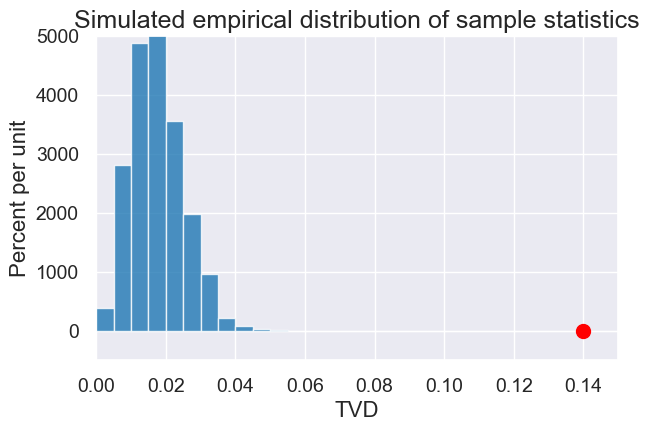
2. Is Coin Biased in Favor of Tails?#
Recall, we create a simulation from our null hypothesis.
# Inputs to our hypothesis test simulation
observed_num_flips = 100
null_hypothesis_proportions = make_array(0.5, 0.5)
observed_heads = 31
def plot_biased_coin_simulation(observed_num_flips, observed_heads,
null_hypothesis_proportions, num_trials):
#Null hypothesis model parameter which we will check against simulated
null_hypothesis_percent_heads = 100 * null_hypothesis_proportions.item(0)
#Simulate
simulated_differences_from_null = make_array()
for i in np.arange(num_trials):
coin_flips_sample = sample_proportions(observed_num_flips,
null_hypothesis_proportions)
percent_heads = 100 * coin_flips_sample.item(0)
abs_difference_from_null = abs(percent_heads - null_hypothesis_percent_heads)
simulated_differences_from_null = np.append(simulated_differences_from_null,
abs_difference_from_null)
# Collect results
plot = Table().with_columns("abs(percent heads - 50)",
simulated_differences_from_null).hist()
# Draw a red dot for the statistic on the observed (not simulated) data
observed_percent_heads = 100 * observed_heads / observed_num_flips
observed_statistic = abs(observed_percent_heads - null_hypothesis_percent_heads)
plot.dot(observed_statistic)
plot.set_title("Empirical distribution of the \nsimulated statistic\n under the Null Hypothesis");
plot_biased_coin_simulation(100, 46, make_array(0.5, 0.5), 5000)
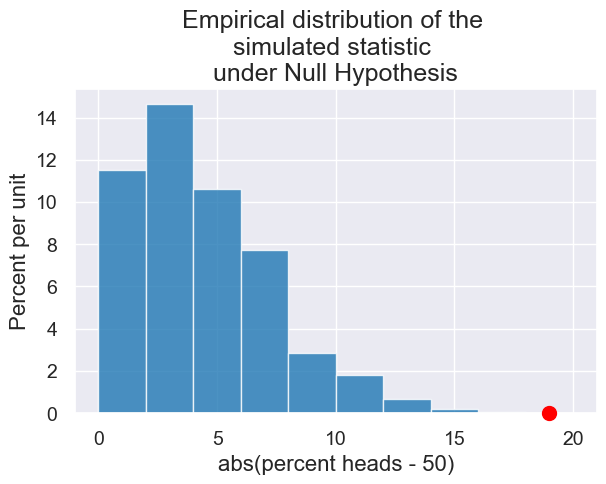
plot_biased_coin_simulation(100, 31, make_array(0.5, 0.5), 5000)
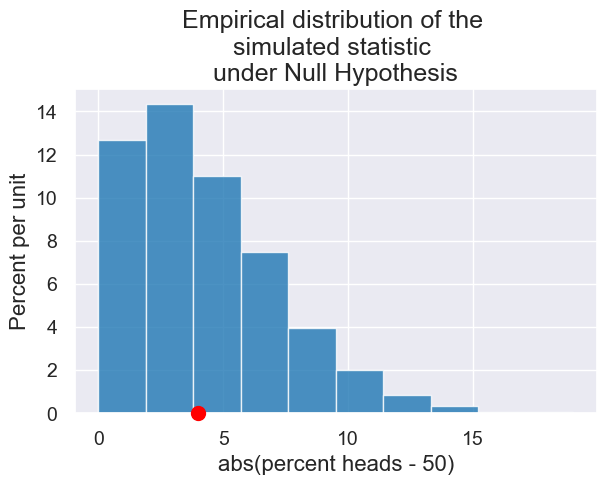
3. Midterm Scores#
Was Lab Section 3 graded differently than that other lab sections, or could their low average score be attributed to the random chance of the students assigned to that section?
scores = Table().read_table("data/scores_by_section.csv")
scores.group("Section", np.mean)
| Section | Midterm mean |
|---|---|
| 1 | 15.5938 |
| 2 | 15.125 |
| 3 | 13.1852 |
| 4 | 14.7667 |
Lab section 3’s observed average score on the midterm
observed_average = np.mean(scores.where("Section", 3).column("Midterm"))
observed_average
13.185185185185185
Number of students in Lab Section 3
observed_sample_size = scores.group("Section").where("Section", 3).column('count').item(0)
observed_sample_size
27
Null hypothesis model: mean of the population
Null hypothesis restated: The mean in any sample should be close to the mean in the population
null_hypothesis_model_parameter = np.mean(scores.column("Midterm"))
null_hypothesis_model_parameter
14.727272727272727
Difference between Lab Section 3’s average midterm score and the average midterm score across all students
observed_statistic = abs(observed_average - null_hypothesis_model_parameter)
observed_statistic
1.5420875420875415
def sample_scores(sample_size):
# Note: we're using with_replacement=False here because we don't
# want to sample the same student's score twice.
return scores.sample(sample_size, with_replacement=False).column("Midterm")
def simulate_scores(observed_sample_size, num_trials):
simulated_midterm_scores = make_array()
for i in np.arange(0, num_trials):
one_sample = sample_scores(observed_sample_size)
abs_difference_from_null = abs(np.mean(one_sample) - null_hypothesis_model_parameter)
simulated_midterm_scores = np.append(simulated_midterm_scores,
abs_difference_from_null)
return simulated_midterm_scores
simulated_midterm_scores = simulate_scores(observed_sample_size, 3000)
results = Table().with_columns("abs(sample mean - class mean)", simulated_midterm_scores)
plot = results.hist()
plot.dot(abs(observed_average - null_hypothesis_model_parameter))
plot.set_title("Empirical distribution of the \nsimulated statistic \nunder Null Hypothesis");
